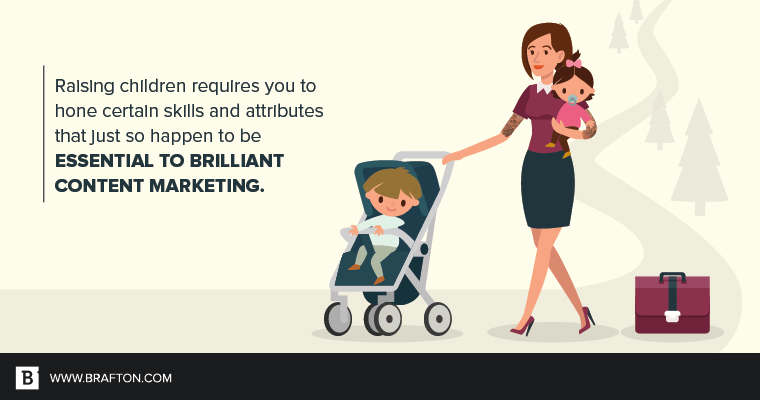Becoming a parent changes you. One minute you’re dancing on top of a table in Cancun, the next you’re pushing a double stroller through Costco. And although swapping daiquiris for diaper duty may render your Saturday nights slightly less epic, parenting has its rewards. It could even boost your business.
Raising children requires you to hone certain skills and attributes that just so happen to be essential to brilliant content marketing.
(And you thought all those hours spent making Mickey Mouse pancakes and playing I Spy were for naught.)
Whether you’re in the midst of targeting mid-funnel prospects or just starting out, keep these content marketing best practices top of mind to take your company to new heights.
Here are four reasons why parents have a running start at content marketing success:
1. Parents are top-notch planners
Imagine taking your kids to the beach and winging it – running out the door on a whim with nothing but your car keys, cellphone and wallet. Obviously, that would result in total disaster.
When kids are in the mix there are lunches to prepare, coolers to fill and diaper bags to pack. There are the sand toys – so many sand toys. You need to arrive early if you’re to have any chance of making it back home by naptime. And you should map out an alternate route in case of traffic.
Wait – is there enough space in the trunk for the pop-up tent and beach cart?
Just as you wouldn’t dare go to the beach without the proper supplies and preparation, you’d be foolish to roll out a content marketing campaign without a solid plan in place.
Begin by identifying and defining your goal (lead generations, conversions, etc.), then conduct persona research and align your content type and messaging to your buyer’s journey.
For example, let’s say your goal is brand awareness – reach your target audience with engaging top-of-funnel content like blog posts, videos or infographics. You want people’s reaction to be, “I like this and I want to know more.”
If you find yourself winging it midway through, you probably don’t know what you’re trying to achieve, in which case you need to go back to the drawing board.

2. Parents are used to focusing on others
When you become a parent, you quickly realize that it’s not all about you anymore.
There’s a new sheriff in town and your needs and wants are secondary to his. Once upon a time, you enjoyed sleeping in on weekends, lounging on the couch and going out for drinks. Now you’re all about that #momlife or #dadlife – waking up at 5 a.m., kicking it at the playground and contemplating creative ways to hide vegetables in muffins.
Shifting the focus from yourself to others is not only parenting 101, it’s also a tenet of successful content marketing.
When you talk at your audience, you’re basically speaking into a vast abyss. People don’t want to hear about how great your products or services are – they want to consume content that they care about and can relate to.
If you’re trying to sell a widget to a facilities manager, don’t focus on its features; you’re better off using storytelling to paint a picture of the many ways that widget could solve your customer’s pain points.
3. Parents know tricks to placate short attention spans
Have you ever tried teaching your preschooler to complete a new task like tying a shoe or writing his or her name? It’s amazing how easily sounds and objects can distract a young child from completing the activity at hand. Over time, however, parents learn to implement techniques to help their kids focus, such as breaking up the task into shorter chunks or turning off the television.
In 2015 Microsoft studied the human attention span and found that it was a measly eight seconds long – even shorter than that of a goldfish.
While that claim might be a bit of stretch, modern consumers do have infinite data at their fingertips, which means if a Netflix show or blog post doesn’t appeal to them, they can easily move on to the next one with a tap or swipe of the thumb. This makes it all the more critical for marketers to know their audience and tailor content accordingly.
Just as you can’t spy on your nanny without hiding a camera in a houseplant, you can’t reach certain consumers without utilizing video and visual content.

Video appeals to folks with short attention spans and can boost conversions by as much as 80 percent when included on landing pages.
Moreso, 84 percent of people have reported that watching a video has convinced them to make a purchase.
Meanwhile, infographics are giving Beyonce a run for her money in terms of breaking the internet – the eye-catching visuals are shared and liked on social media three times more often than all other content types.
4. Parents prioritize quality over quantity
When you work outside the home, it’s crucial you make good use of the time you have together in the evenings and on weekends. After all, it’s not the quantity of hours you spend together that matters, it’s the quality. As long as you’re giving your best effort and taking care to have meaningful interactions with your kids, it’ll result in a healthy relationship.
The same theory applies to content marketing: quality trumps quantity.
When you invest an abundance of time and resources into creating an arsenal of content, there’s an opportunity cost involved. You also risk producing mediocre content in your rush to get more pages indexed.
Quantity will come with time. Focus on quality – and on satisfying searcher intent – and eventually, you’ll have a quantity of quality work.
Content marketing doesn’t produce results overnight. It’s important to stay the course, rely on data and continue to tweak your efforts to achieve your goals. Like parenting, content marketing isn’t a sprint to the finish line – it’s a marathon. You got this.





